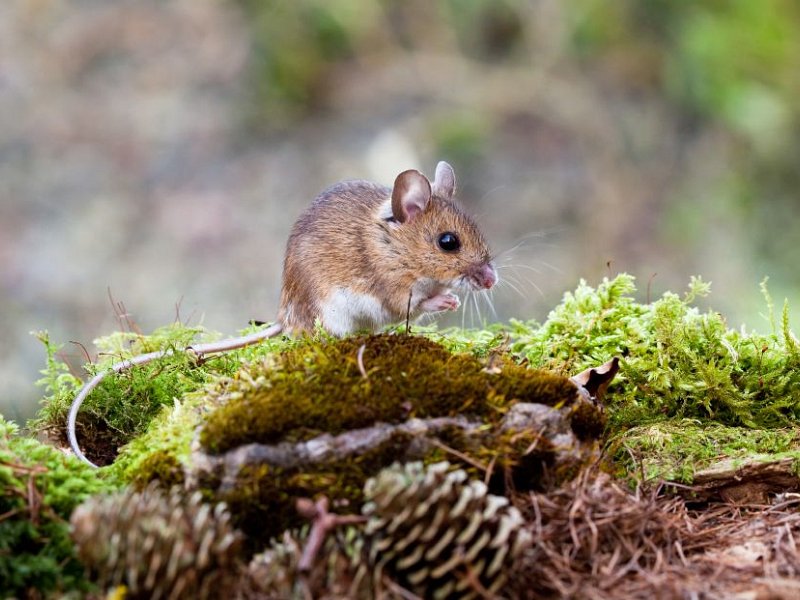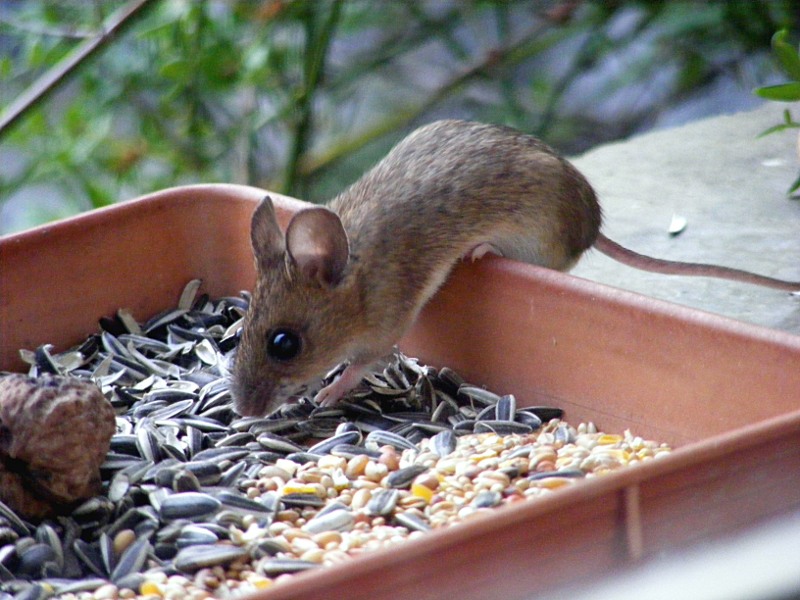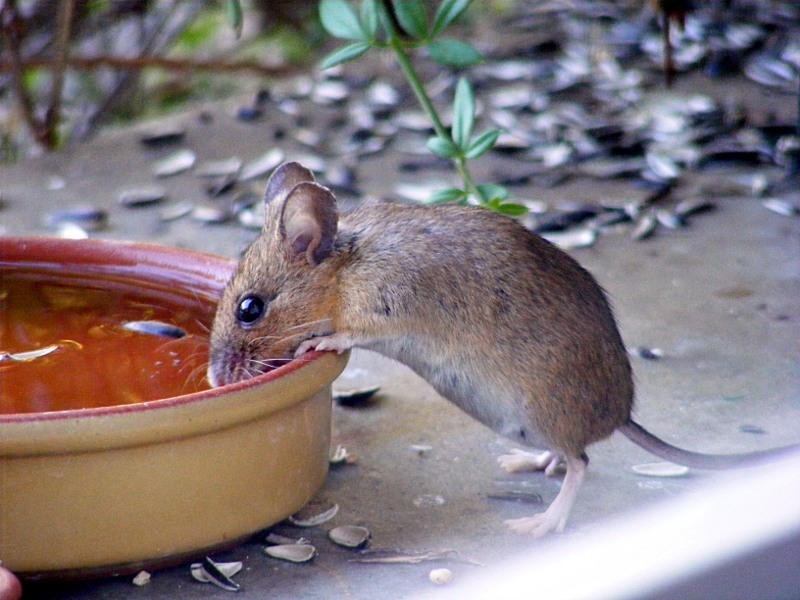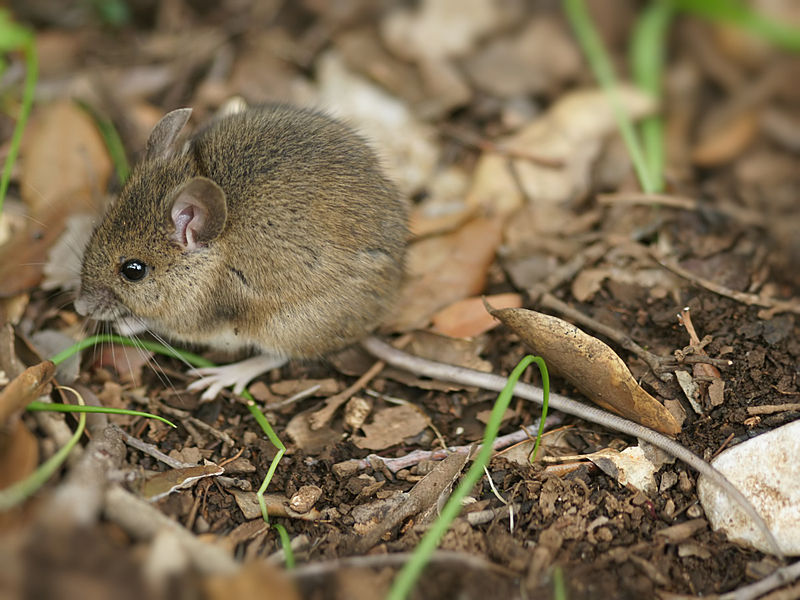Legal Status
- Wildlife Act 1976 / 2000
- EU Directive 92/43 Annex IV
- Bern Convention Appendix II
- Bonn Eurobats Convention Appendix II
Key Identification Features
The wood mouse, also known as the long tailed field mouse is often mistaken for the only other resident species of mouse in Ireland, the common house mouse. Wood mice are a dark brown colour on their backs with a yellow to brown on their flanks and have a greyish white underbelly. Juveniles are grey in colour. The main distinguishing features which separate the two Irish mouse species are that wood mice have larger eyes, ears and a much longer tail, their hind legs are also much larger in proportion to their body size measuring up to 3cm in length. Tracks of the species leave a four-toed impression with the front feet while the hind feet are five-toed. Head and body length can reach up to 10cm for both male and female adults with a tail containing fewer rings than the house mouse measuring up to 9cm in length. Adult males are slightly heavier than females weighing up to 27 grams, on average about 4 grams heavier than females. Large eyes give the wood mouse excellent vision with their sense of smell also being highly developed. Movement can be described as fast and alert with an ability to leap, swim and climb when necessary. Vocalizations include a range of squeaks and the use of ultrasound by the males during mating.
Habitat
As the name suggests the wood mouse can be found in an Irish woodland type such as coniferous, deciduous and mixed forests. They are a highly adaptable animal and can now be found in a range of different habitat types including hedgerows, agricultural land, sand dunes, bramble and bracken scrub, gardens, blanket bog and open grasslands. The only habitat areas which are unsuitable for wood mice are water logged lands. Individual wood mice have home ranges of up to three hectares but one hectare in Ireland is the norm. Home ranges vary depending on the individual mouse, the supply of food each range can provide and the type of habitat in which the mouse is located. Nests which are lined with chopped or shredded grass can normally be found underground but in colder winters the wood mouse will use buildings which are not occupied by the more common house mouse species. Underground burrows are dug in soft ground and can contain a number of tunnels and chambers, some chambers act as food stores with a nest room located deeper in the earth where it is warmer.
Food and Feeding Habits
Wood mice can be described as opportunistic omnivores. The bulk of their diets are composed of seeds such as acorns, beech mast and conifer seeds. If available they will consume fruits, berries, buds, fungi, nuts, roots, cereals and bulbs. They will hunt small invertebrate prey which are located in their habitats such as earthworms, snails, centipedes and insect larvae with wood mice occupying wooded areas having diets which contain higher levels of such prey than those in more open habitat types. Wood mice feed mainly at night but can occasionally be seen during daylight hours. They have two main active foraging periods each night but this will be restricted to one period in winter. Regular pathways are used to travel to foraging areas and to return with surplus food for storage underground. In periods of plentiful seed growth the wood mouse may be able to collect enough food to last it through the year although a supply of seeds which can sustain it through the winter is sufficient.
Reproduction and Life Cycle
The breeding season of the wood mouse in Ireland begins in March and runs until October although if conditions are suitable breeding may occur all year long. For most of the winter communal nests of both sexes are established containing several individuals but when the breeding season begins females become territorial and less tolerant of other females in their breeding territory. After a pregnancy lasting three weeks breeding females give birth to a litter averaging around five young which are born naked and blind and weigh only 2 grams. Parental care is given by females only, with the individuals from the litter inheriting the nest once their mother has died. Most breeding females will produce more than one litter a season with the first pregnancy being the shortest. The young mice are fully weaned after three weeks with individuals born early in the season maturing in time to breed themselves before the year ends. The mortality rate for newborn wood mice can be as high as 90% in their first year which does not lessen dramatically in their second year of life like most other mammals in Ireland. The average live span of an Irish wood mouse is thought to be only 20 months long.
Current Distribution
The wood mouse species is originally a native of the warm grassland areas of Asia and central Europe and would most likely have lived in rock crevices feeding on seeds, grasses and other plants. The wood mouse is currently widespread over much of western Europe and parts of Asia that still have large wooded areas. They are generally absent from colder areas of northern Scandinavia and Russia. It is now one of Ireland’s most common mammals and can be found in most habitat types including several offshore islands. They are believed to have been resident here for up to 8,000 years with their population being increased regularly in the following centuries due to having been accidentally brought over on Viking and other medieval boats from Europe. The Irish wood mouse is closely related to populations found in Scandinavia and mainland Europe which indicates that it was repeatedly brought here over the last several centuries. Population densities vary considerably depending on the time of year, availability of food and the habitat type which they occupy. In their preferred habitats of yew forests there may be up to ninety individuals per hectare by early autumn with a coniferous forest containing only a maximum of twenty at the same time of year. Wood mice populations in Ireland are at their lowest in early spring especially if the proceeding winter was excessively harsh.
Conservation Issues
The Irish wood mouse does not spread disease and rarely reaches population densities which can cause economic damage although some seed and grain stores may suffer losses in the summer and early autumn. As the Irish countryside does not support a large variety of small animal species the wood mouse is an important prey item for a number of our larger predatory mammals such as stoats, badgers, foxes and pine martins. It is also important for the continued survival of several Irish birds of prey such as hawks, kestrels, and owls. As the yearly mortality rate of wood mice can be as high as 90% in some areas they are sensitive to large-scale changes in their local environments especially those found in rural habitats during the harvesting season of cereal crops. Wood mice found in more urban habitats are susceptible to indirect poisonings from mercury and lead which can run-off roads into their local ecosystems. As the species is considered widespread and not in any danger it is not protected by any legislation.



